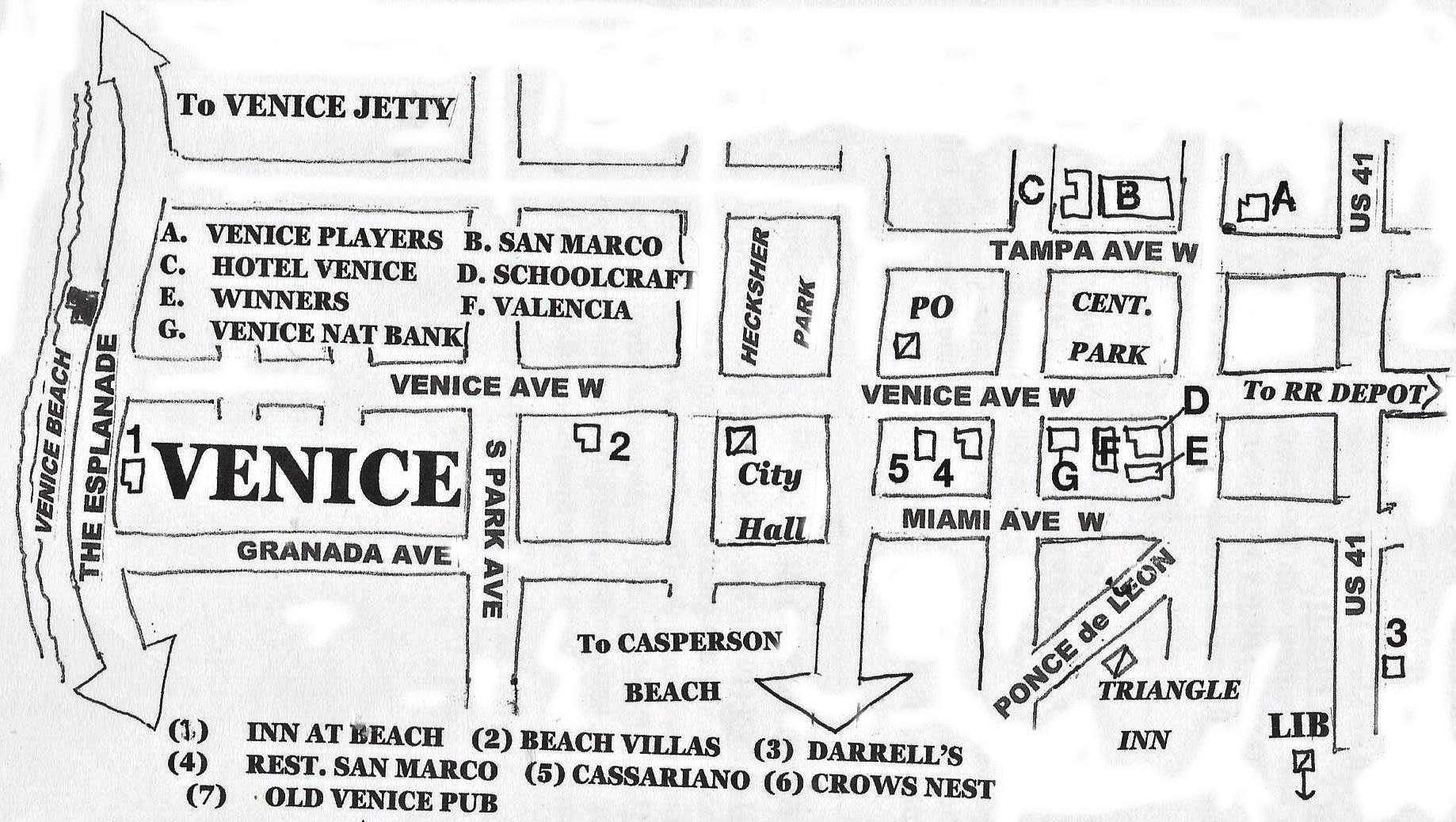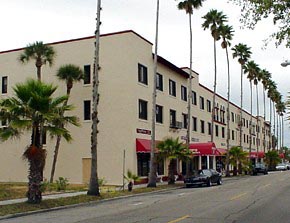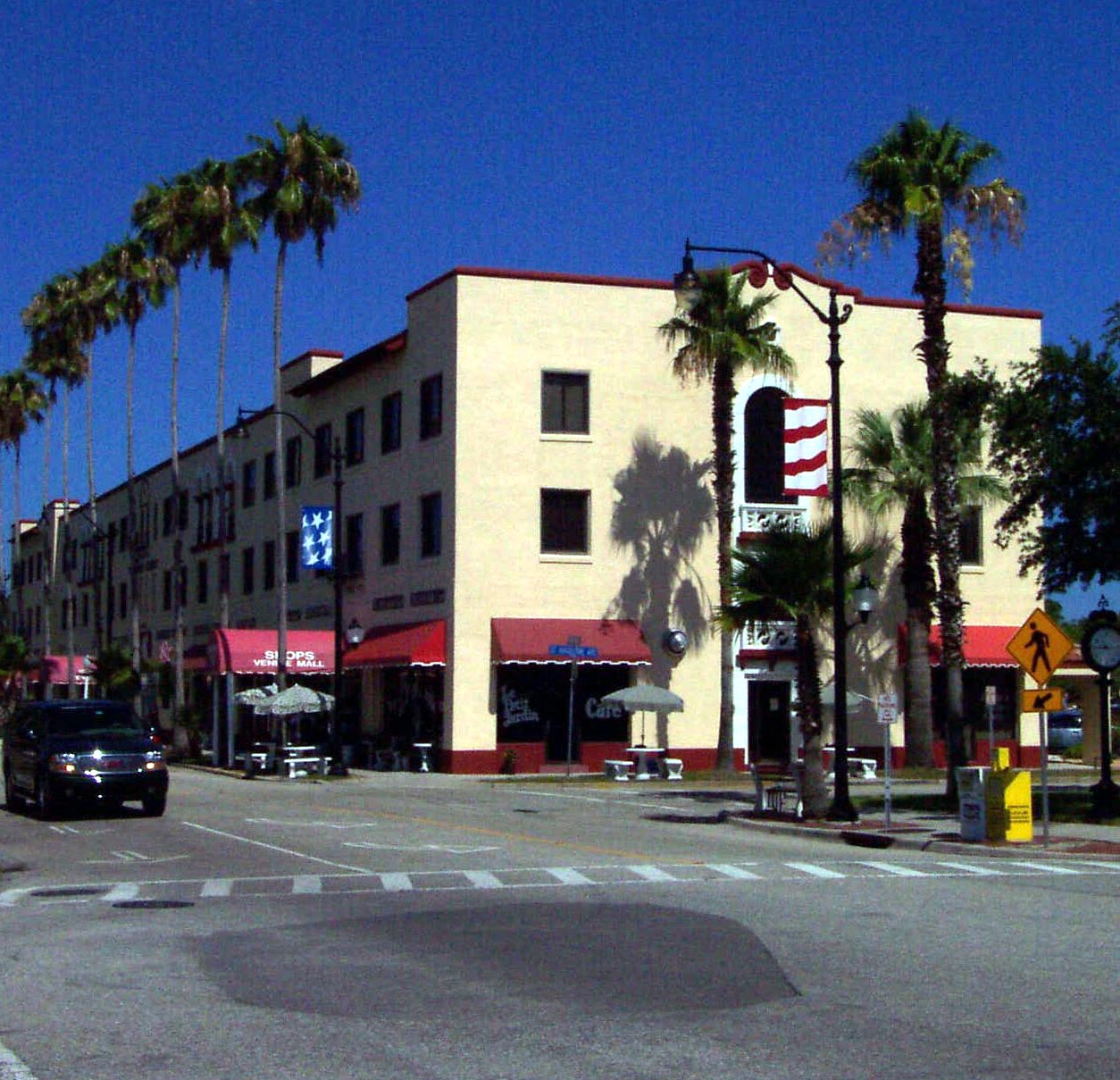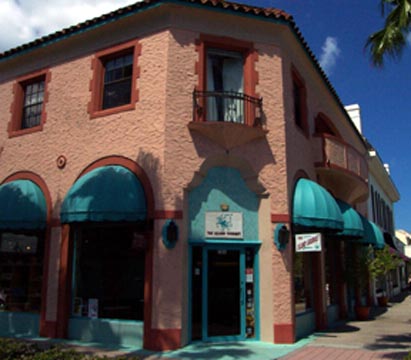HISTORIC VENICE (Sarasota County)
NO LONGER A RAILROAD
RETIREMENT TOWN
For more information on Venice - visit:
THE CITY OF VENICE, FLORIDA;
and VENICE CHAMBER OF COMMERCE
The area north of Venice
Bay was settled by the 1860's by
homesteaders like Jesse Knight, a Methodist preacher from Georgia, and was known as Horse
and Chaise. In 1882 chemist Frank Higel, who once
lived in Venice, Italy, arrived and promoted the
region to Northerners like lawyer Joseph H. Lord and Lord's friend Mrs. Potter
Palmer whose purchase of thousands of acres influenced area development for
years

In 1925 the Brotherhood of Locomotive
Engineers obtained 50,000 acres from surgeon Dr. Fred Albee,
and hired Boston
architect John Nolen to design a farming and retirement city, complete
with resort hotels, wide avenues, a residential area (Gulf View), and waterways.
WHERE TO START: EXIT
BUSINESS US41 and drive East on VENICE AVENUE to downtown area. This area
east to Nokomis Avenue and south to Miami Street was part of Joseph Land's
1915 Venice
subdivision.


CROSS NOKOMIS.
On your left is the five story ALBERT
BLACKBURN BUILDING(Schoolcraft Building)
(1926), 201 Venice Avenue, a business block which
featured a pharmacy with upstairs apartments. I always loved the awnings on this structure and the second story balconies - not your average commercial building with five downstairs shops and upstairs apartments. At 229 Venice Avenue is the EL PATIO HOTEL(Valencia
Hotel) (1926), a fine Mediterranean Revival hotel that has greeted winter
tourist and circus people for decades.Stanton Ennes of the Brotherhood of Locomotive
Engineers designed the neat arcade and even a post office.
Also part of this historic commercial block
at 247 Venice is the 1927 HOWARD ELECTRIC
COMPANY BUILDING One block over is the 1940 ESTES
BUILDING.


You willl want to cross the beautiful greenway
northward to the huge complex of buildings on Tampa Avenue.Around the corner at 200 North Nassau is the Italian Renaissance HOTEL VENICE
(1926), built by the George Fuller Company as a three story resort. John Nolen
designed the Northern Italian structure complete with campanile. He hired
Charles Kane of San Francisco's St. Francis
Hotel as first manager. Thomas Edison, Ty Cobb, and William J. Burns stayed here in the Land Boom.
Kentucky Military Institute obtained the place as a student dorm in 1932 and
now it is a 78 room retirement center.
At 238 West Tampa on the wide Center Mall is the three-story SAN MARCO HOTEL
(1927), third of the large Venice
resorts. Designed by Tampan Franklin O. Adams and
constructed by R. W. Wishart,who did the hotels on Davis Islands
(Tampa), San
Marco was utilized from 1932 to 1970 as the winter home of Kentucky Military
Institute before its condo/shop restoration.
Before TURNING
RIGHT ON NOKOMIS, notice at 140 West Tampa Avenue, the VENICE
LITTLE THEATER (1927), a converted Sinclair garage to movie house, then gym for
K.M.I. This fine drama group started in 1950 in a World War II quonset hut at the airport. My mother, an English movie star and dancer, used to do the dance
instruction for musicals here.
DRIVE
SOUTH ON NOKOMIS ACROSS VENICE AVENUE. At the right apex of Miami and Ponce de Leon is the (6) HOLLYWOOD
APARTMENTS (BURGUNDY SQUARE), a 1926 two story
Italian Renaissance boom hotel.Two
structures on Miami to note is the 1925 H.N. BUD WINNERS REALTY at 221 Miamiis a neat Mediterranean Revival
with arched windows, and the 1926 L..M. L. M. TEAL BUILDINGat 225 West Miami.
Two blocks south on the right are some
indications of Venice's strong cultural
community: THE VENICE LIBRARY, 300 South
Nokomis, with a collection of historical and architectural
materials. Two of the library's benefactors are Rosemary and Walter Farley who
wrote The Black Stallion. Nearby is the Venice Community
Center and the Venice Art League.
TURN RIGHT ON TURN, RIGHT ON PENSACOLA, and LEFT ON VALENCIA to reach Harbor Drive. TURN RIGHT (north) on
HARBOR DRIVE toward downtown.
At 241 South Harbor Drive is the GEORGE
YOUNGBERG HOUSE (1926), the Italian Mediterranean home of the engineer
of the Venice Project, and later Mayor James T. Blalock. At 519 South Harbor is
a wonderful bed and breakfast THE BANYAN HOUSE, a 1926 stucco mansion
built for archaeologist Dr S. M. Thomas.
The oldest place in the city is the 1896 JOSEPH H. LORD HOUSE at 409 Granada. PASS GRANADA where you'll see the VENICE CITY HALL
(1925), 401 West Venice Avenue, designed byJohn Nolen.
TURN LEFT ON VENICE AVENUE toward the Gulf of Mexico,
passing many 1920's houses. The Avenue ends at Venice Beach
and the VENICE BEACH PAVILION (1963), by David Hamilton.
Off White Cap Circle is the FRANK HIGEL
MARINE PARK,
on Roberts Bay,
named for the Philadelphia publisher who boosted
Venice. The harborside spot has restrooms, picnic tables, and a boating
viewpoint. AT THE TIP OF TARPON CENTER is the popular SOUTH JETTIES PARK
where two acres of huge rocks fill with fishermen and strollers.
Parking is limited but taking a beach visit
is popular. RETURN TO HARBOR DRIVE (see map) and DRIVE
SOUTHWARD if you wish to visit other beach areas. Off Beach Boulevard is GOLDEN BEACH,
famous for its black shark teeth.
If you turn left
on Shore Drive and continue on Airport Avenue, you will see VENICE
AIR FIELD (1939), started by the P.W.A. and later serving as an Army
Air base, complete with 200 German prisoners. At the end was the RINGLING BROTHERS &
BARNUM & BAILEY CIRCUS WINTER HEADQUARTERS now departed.
RETURN TO HARBOR DRIVE
if you wish to travel south past the 700 foot VENICE PIER to CASPERSON
BEACH COUNTY PARK, 113
acres of dunes and palmetto woods. There are full facilities in this park,
named after Finn Casperson who pioneered the Venice
Aviation Club. Popular Sharkey's On The Pier is a good
stop to view the sunset and have food. This is the best place on the Gulf Coast to find shark teeth. .
OTHER BUILDINGS TO SEE:
TRIANGLE INN (1926), Nassau Street at Pensacola Road, is a two story Italian
Renaissance building designed by Walker and Gillette, with a notable round
turret. The building now houses the City of Venice Museum and Archives.
IRA A. HINES Building, 200 St. Augustine Street,
was built in 1927 as a tea room, drug store, antique store, and gift shop. Also nearby is the house at 616 LaGuna is a fine Boom Time Spanish-Mediterranean home.






